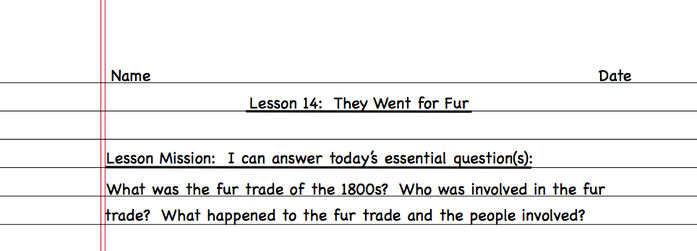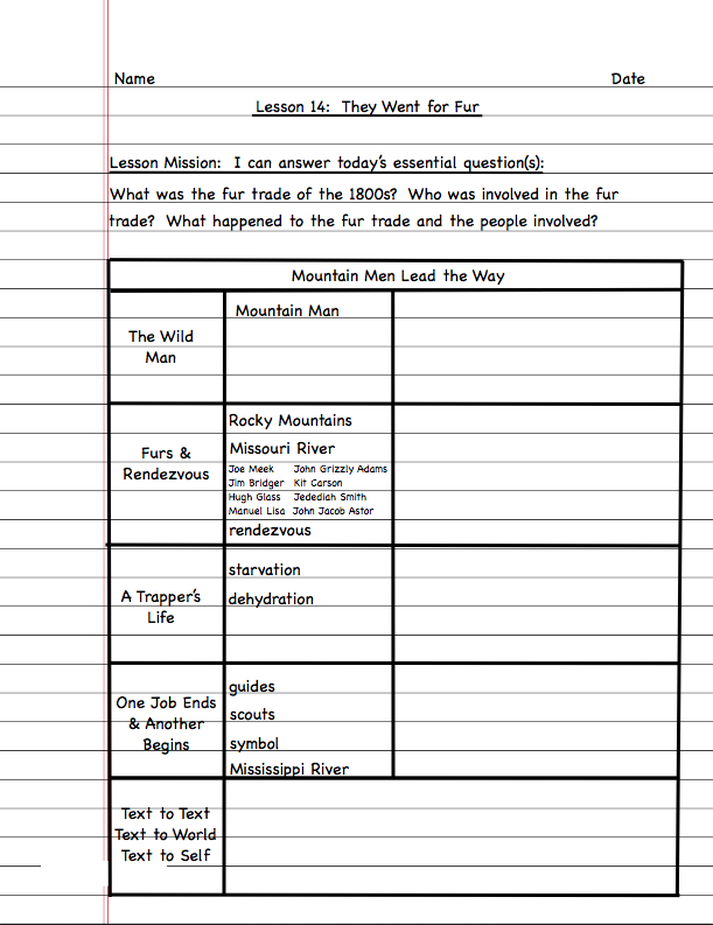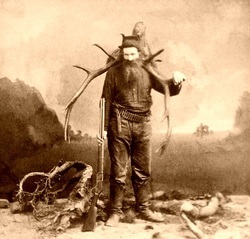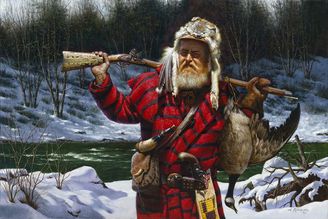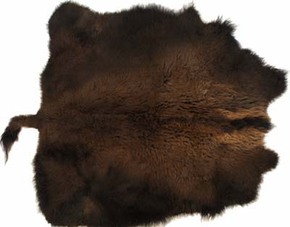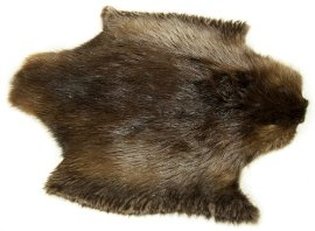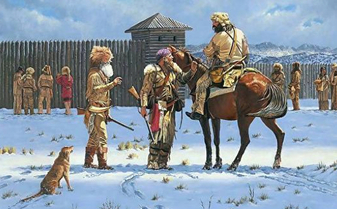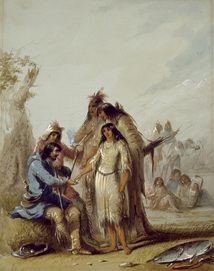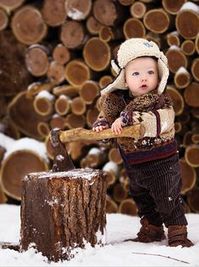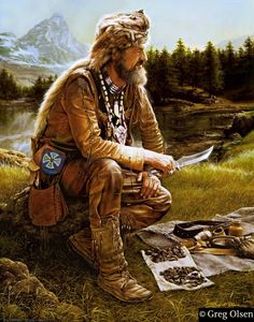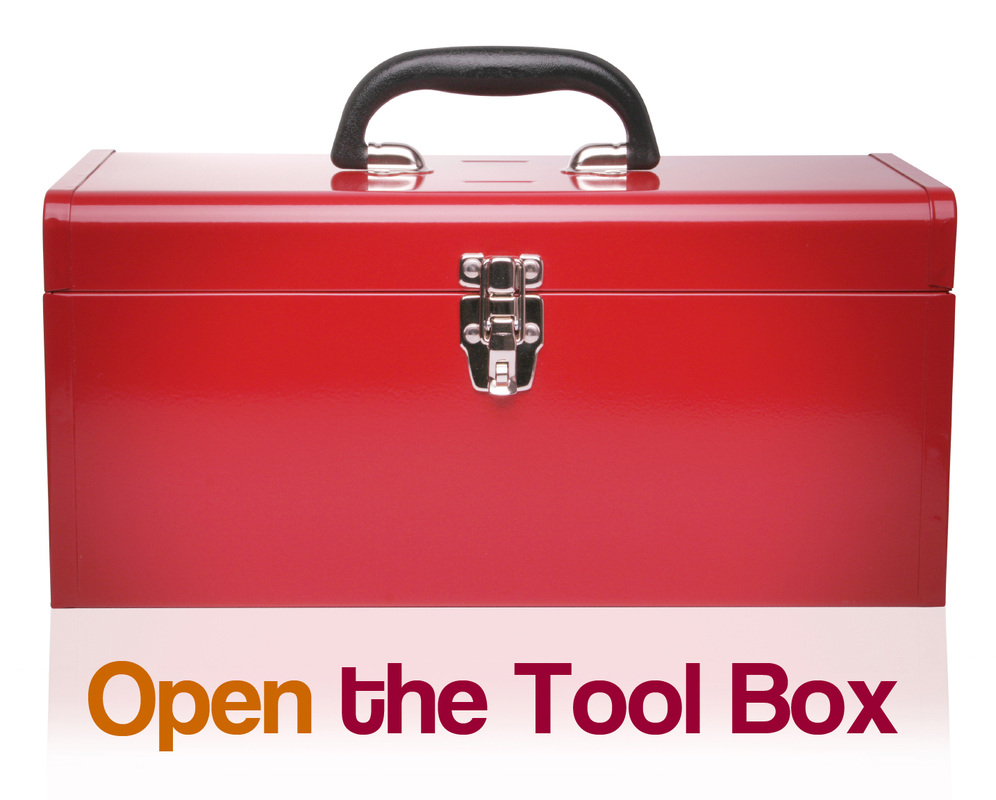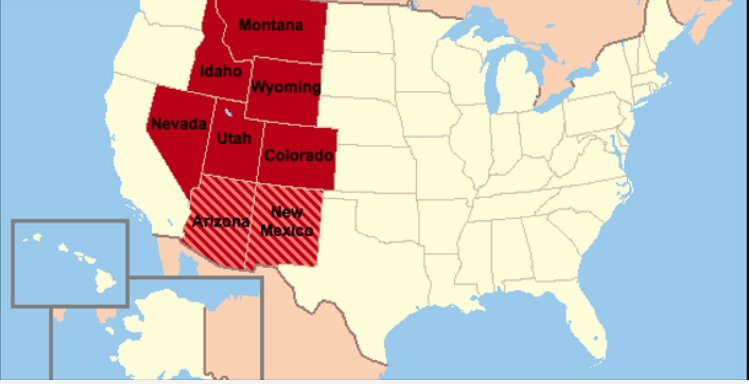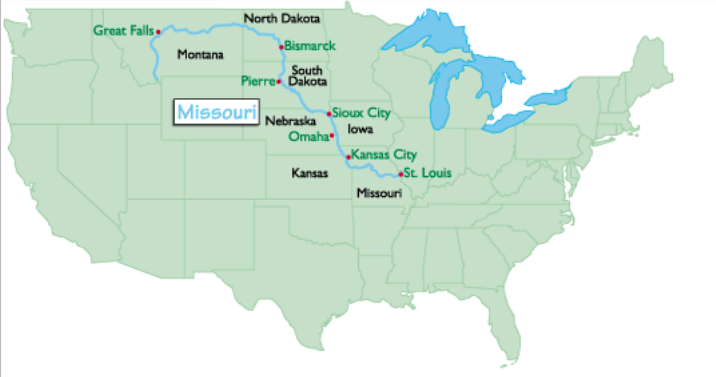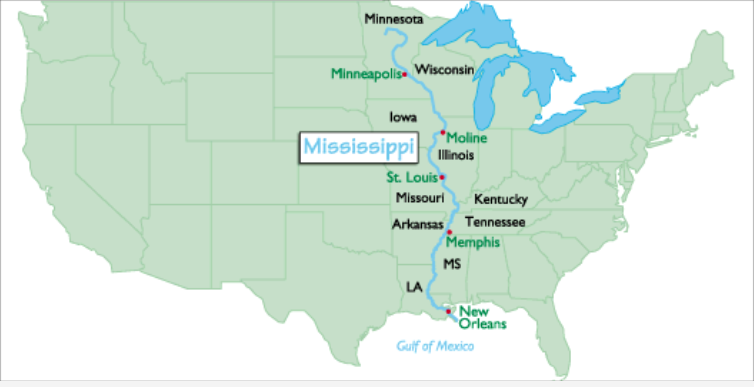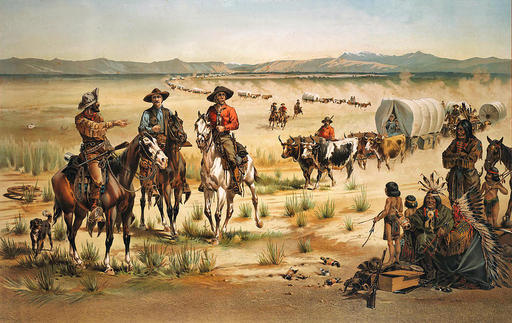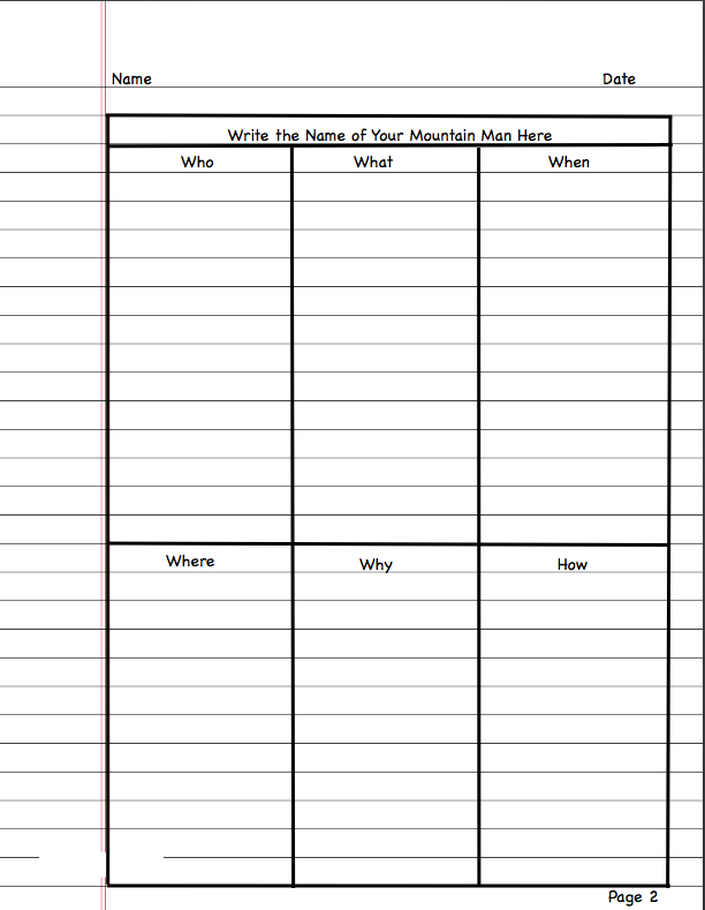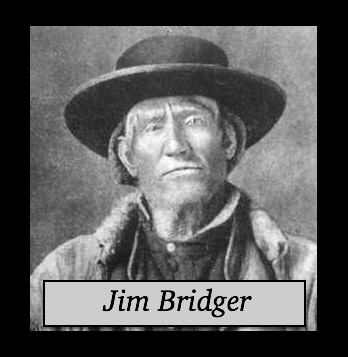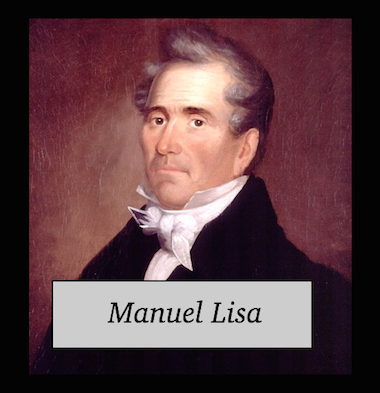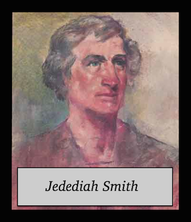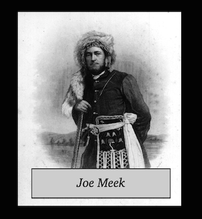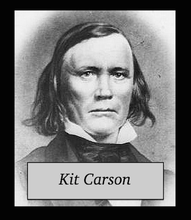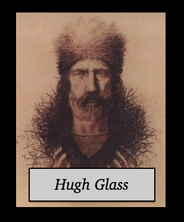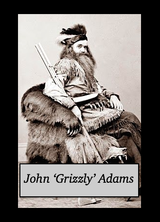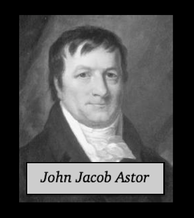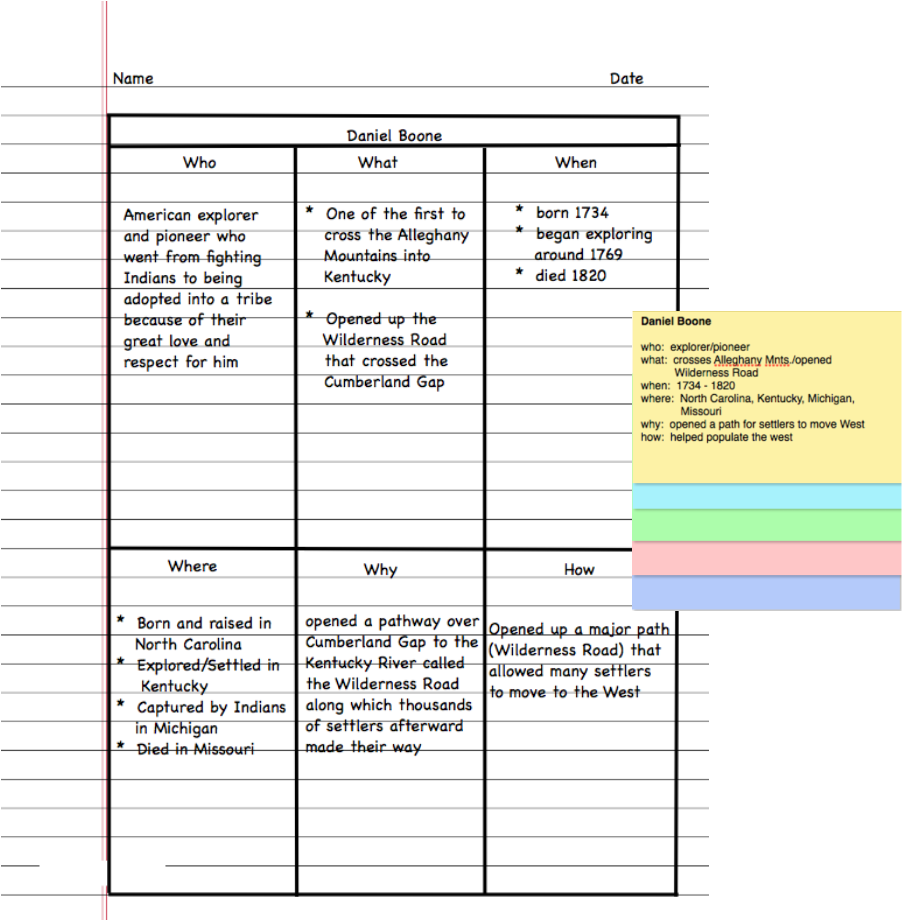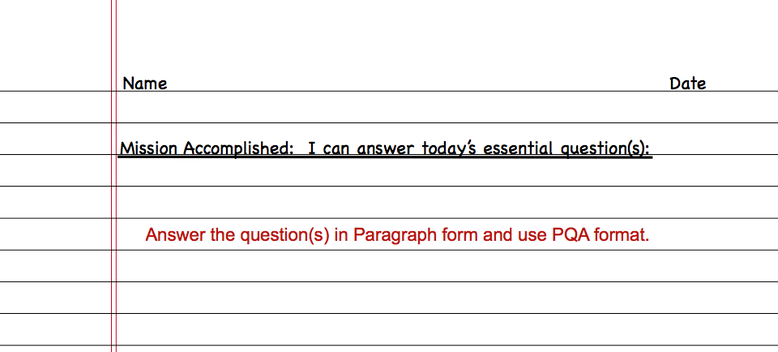LESSON 14:
THEY WENT FOR FUR
FOCUS ACTIVITY
Lesson Mission
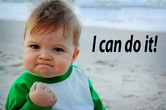
DIRECTIONS: Remember, the Lesson Mission is what you, the student, will be able to do after the lesson is over. Begin today's Lesson Chronicles Entry by heading your paper with your name and the date and the Lesson Title. Write down today's essential question. Answering the essential question at the end of the lesson is your Lesson Mission!
Essential Question(s):
What was the fur trade in the 1800s? Who was involved in the fur trade? What happened to the fur trade and the people involved?
Essential Question(s):
What was the fur trade in the 1800s? Who was involved in the fur trade? What happened to the fur trade and the people involved?
Set up your Lesson Chronicles Entry for Lesson 14.
TEACHING ACTIVITY
Skeleton Outline
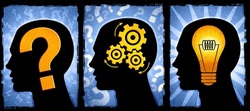
DIRECTIONS: Remember, accomplishing your lesson mission is your purpose for reading. To accomplish your mission, you must be able to answer the essential question(s). We will continue to work on answering essential questions by identifying information from key text structures to make a skeleton outline of the text.
Recall the Key Text Structures in Non-Fiction Text:
1. Headers
2. Sub-headers
3. Bolded Words
4. Italicized Words
5. Pictures & Captions
6. Boxed off Information
7. Charts and Graphs
8. Maps
Questions to ask yourself when creating a Skeleton Outline:
1. Column 1: What are the headers and sub-headers?
2. Column 2: What else is important in the reading?
4. Bottom Row: Leave blank until you read.
Recall the Key Text Structures in Non-Fiction Text:
1. Headers
2. Sub-headers
3. Bolded Words
4. Italicized Words
5. Pictures & Captions
6. Boxed off Information
7. Charts and Graphs
8. Maps
Questions to ask yourself when creating a Skeleton Outline:
1. Column 1: What are the headers and sub-headers?
2. Column 2: What else is important in the reading?
- What words are bolded or italicized?
- What are the pictures of and what do the captions say?
- What information is squared off into boxes?
- What are the maps, graphs, and charts telling you?
4. Bottom Row: Leave blank until you read.
Set up your Skeleton Outline in your Lesson 14 Chronicles under the Lesson Mission.
WHOLE GROUP ACTIVITY
Part 1: Guided Reading & Cornell Notes
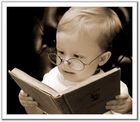
DIRECTIONS: Now that you have a purpose for reading, and you have identified the key elements of the reading, we will take turns reading the passage below as a class.
As we read, you need to record your notes in the last column.
Recall the things you should include in notes on a text:
1. What is the main ideas of each section?
2. What words do you need to define?
3. What people are mentioned and how are they important?
4. Is there any sequenced information?
5. Is there a causes and effect relationship?
6. Is anything compared and contrasted?
7. Is there a problem that needs a solution or is solved?
8. What is the conclusion or result?
As you read, if a certain part of the reading makes you think of a text to text, text to self, or text to world connection, write it in the bottom row.
Recall the text to text, text to self, and text to world strategy:
As we read, you need to record your notes in the last column.
Recall the things you should include in notes on a text:
1. What is the main ideas of each section?
2. What words do you need to define?
3. What people are mentioned and how are they important?
4. Is there any sequenced information?
5. Is there a causes and effect relationship?
6. Is anything compared and contrasted?
7. Is there a problem that needs a solution or is solved?
8. What is the conclusion or result?
As you read, if a certain part of the reading makes you think of a text to text, text to self, or text to world connection, write it in the bottom row.
Recall the text to text, text to self, and text to world strategy:
- Text to text references: When a certain word, phrase, or sentence reminds you of something else that you have read.
- Text to self references: When a certain word, phrase, or sentence reminds you of something about your own life.
- Text to world references: When a certain word, phrase, or sentence reminds you of a world issue or event.
Mountain Men Lead the Way!
One Job Ends and Another Begins
 Beaver Fur Hat
Beaver Fur Hat
The fur companies controlled the lives of these trappers, and when the demand for fur declined, the price of furs went with it. By 1850, the beaver hat had gone out of fashion in Europe, and that put an end to the fur trade for most Mountain Men. Most of them entered into new businesses such as lumbering, mining, and railroading.
|
Many mountain men became guides for those making the journey across the Plains to California and by the mid 1840s most of the routes to the west were well travelled and the guides' main role was to help travellers to survive the harsh conditions and handle encounters with the Indians.
|
Mountain men also became invaluable guides and scouts for wagon trains, survey teams, and the army. Their skills in living off the land and their knowledge of Native Americans helped bring many pioneers safely across the country.
Not only were the mountain men a symbol of America’s wild frontier, their role in westward expansion was also very important. They did not simply wander around the Rocky Mountains or the Pacific Coast waiting for people to tell adventure stories and tall tales about their lives. They were explorers and guides who helped settle the land west of the Mississippi. |
Part 2: Completing Cornell Notes & Reading Questions
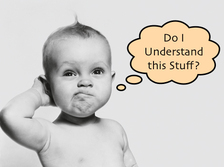
DIRECTIONS: After reading, you will click on the button below and put in the password given to you in class to view what you should have in your notes. We will then discuss why these things are important and talk about the reading as a whole class.
SMALL GROUP ACTIVITY
Part 1: Researching the 411
DIRECTIONS: In this activity, each group will get the 411 information on an assigned Mountain Man and report it to the class. Remember 411 - is the following things:
- Who was this Mountain Man?
- What did this Mountain Man do?
- When did this Mountain Man live?
- Where did this Mountain Man live?
- Why is it important to know about this Mountain Man?
- How did this Mountain Man impact American History?
Set up your 411 Chart in your Lesson 14 Chronicles under your Cornell Notes.
Mountain Men Research Icons
Click on the picture of the Mountain Man under your group number to complete your research.
Part 2: Pass and Splash!
DIRECTIONS: In this activity, each group will pass their 411 information about their assigned Mountain Man to the group who's number comes after theirs. Group 8 will give theirs to Group 1. For each Mountain Man, each group will have one minute to write down the name of the Mountain Man and one key word from each of the 411 categories that describe that Mountain Man on a sticky note. You will create a flip book of all 8 Mountain Men, 9 including the example I am about to give you for Daniel Boone.
Look and listen as I go over the example below.
INDIVIDUAL ACTIVITY
Lesson Chronicles - Answering the Essential Question
A Lesson Chronicles Activity is an individual activity where you prove that you accomplished the lesson mission. Lesson Chronicles require you to keep a notebook or journal with a table of contents. Each entry should be dated. First, you write the lesson mission. Then you prove you "can do" whatever the mission says by answering the essential question of the lesson in PQA format. Remember PQA format means "Put the Question in the Answer".
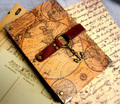
DIRECTIONS: Work by yourself to prove you have completed today's mission successfully by answering the essential question for today.
HOMEWORK
Family Time
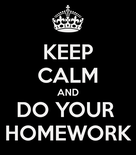
Remember, you have homework every night in Social Studies. Your homework is to show your Lesson Chronicles to your family and tell them what you learned today. Not only will this give you quality time with your family but it will help you review for your unit test. Go over your lesson chronicles entry from today everyday to help you study for the Topic Quiz and Unit Test.
END OF LESSON 14 MODULE
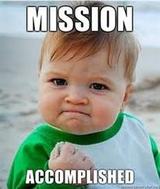
Congratulations! You have completed Lesson 14 Module!
Want to Know more about Mountain Men? Click on the link below to go to Spartacus Education and learn about many more Mountain Men.
